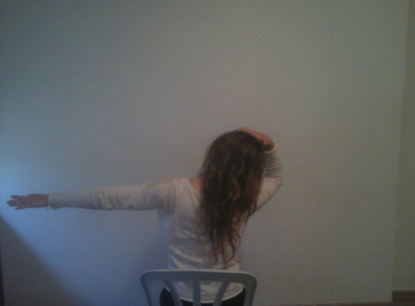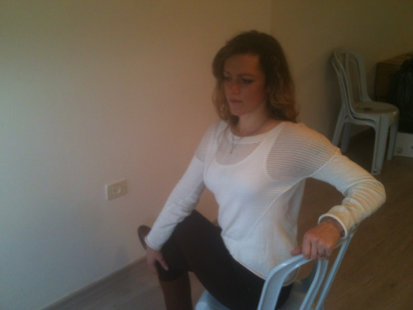If you spend a lot of time at the computer, you probably feel tension in your shoulders and upper back. A few simple stretches outlined below by Ingrid Aria E-RYT and Jerusalem based therapeutic yoga teacher can help to reduce strain in the neck, shoulders and upper back.
Contributing Author: Ingrid Aria
Close your eyes when practicing the neck stretch below. You will release built-up strain from looking at the computer screen for long periods of time.
Neck Stretch:
Sit towards the edge of your seat with your feet placed no more than hip distance apart and your knees equally distanced. On your next inhalation, visualize yourself sitting tall, as if your spine is the trunk of a tree growing tall from the ground. (Breath is through nose unless you are congested and breathing through your nostrils feels forced.) On your next exhalation, lower your right ear towards your right shoulder, and then slightly lower your chin down towards your right collar bone (lowering your gaze toward the floor).
Place your right hand on the top of your head, then move it a little closer to your left ear. Allow your right elbow to point straight forward, not out to the side, so your upper arm forms a near 90’ angle to your torso. This simple action will offer you a feeling of ease from the shoulder to the neck. Now straighten your left arm out to the side, palm facing down. Your left hand should be slightly below shoulder height.
From here, allow your right hand, the hand softly placed on your head, to go on a walkabout. You can move the fingers a little left, forward, back, right, until you find a tender spot. Hold your hand in that spot, keep your left arm straight, reaching out to the left and use the power of your breath here to release the muscles in the left side of the neck.
Your inhalation holds the space of discomfort, the place where you feel that drop of tenderness, and your exhalation releases it through the nostrils. You can use visualization here if you’d like. Count up eight breaths here on this side and then lower your arms, take a few breaths with your hands resting on your lap before you practice on the other side. This exercise helps to release strain in the neck muscles from overuse by turning them off. As a result you will breathe more deeply with greater ease.
Upper and Mid Back Stretch:
Staying on the edge of your seat, cross your left leg over your right. If you are slouching in your lower back place a book underneath your seat to help you sit tall.
On your next inhalation, bring back the visualization of your spine growing tall like the trunk of a tree, and raise your right arm tall overhead, reaching through the tips of your fingers. On your next exhalation, with your left hand resting on the edge of the seat just next to your left hip, slowly rotate your torso to the left, placing your right arm to the outside of your left (top) leg. Check here that your gaze stays in line with the center of your chest to open the chest. Using the power of breath, allow your inhalations to lengthen your spine and your exhalations to gently encourage your right shoulder to roll back (your left elbow can be softly bent. Check that your fingers are not gripping).
Use the strength of your right arm to press against the left (top) thigh so your right shoulder stays in that rolled-back position as well. This will broaden and stretch the front torso and strengthen the upper back .This action of pressing your right arm against your left thigh on the exhalation AFTER you lengthen on your inhalation will also help keep the twist in the upper-mid spine (form the belly button and up). This helps to stretch the muscles that connect the ribs to one another, the intercostals. Adding more length to the intercostals enables us to use fuller lung capacity, making breathing easier, deeper and more detoxifying for the body with no effort.
Take no less than eight breaths on this side before returning to center with uncrossed legs for a few breaths and then practicing on the other side for the same count.
Twists are great for detoxifying the abdominal organs, firing up metabolism, reducing stress and restoring the spine to neutral.
Ingrid Aria E-RYT, has been practicing yoga since 1998 and teaching a diverse range of students since 2009, specializing in intelligent alignment and therapeutic yoga for back care, stress reduction and optimal wellness. Ingrid works with individuals, groups and corporations and leads yoga teacher training workshops. A dedicated student, she is currently studying yoga therapeutics with her teacher, Rachel Krentzman, PT, ERYT Advanced.
For more information: http://theyogahomeschool.com/






 I have been helping people to sit and move comfortably since 1998. I am always looking for ways to help people improve their relationships with their bodies.
I have been helping people to sit and move comfortably since 1998. I am always looking for ways to help people improve their relationships with their bodies.